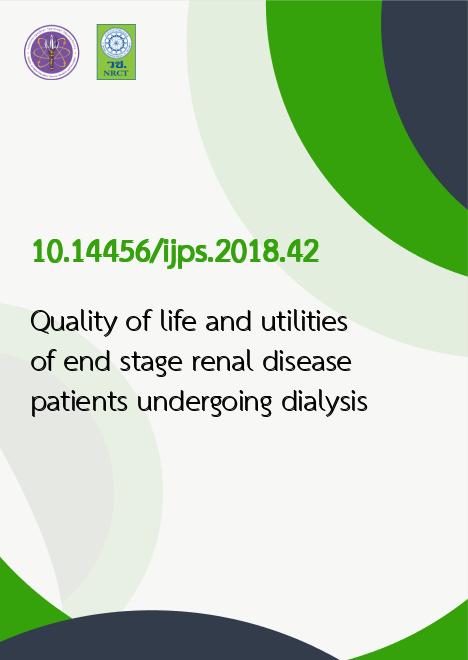
|
Quality of life and utilities of end stage renal disease patients undergoing dialysis |
|---|---|
| รหัสดีโอไอ | |
| Creator | Thananan Rattanachotphanit |
| Title | Quality of life and utilities of end stage renal disease patients undergoing dialysis |
| Contributor | Onanong Waleekhachonloet, Suratchada Chanasopon, Wanarat Ausornsagiam, Juntip Kanjanasilp, Amarit Suwattanasilp, Thanachai Panaput, Sirirat Anutrakulchai, Supon Limwattananon, Chulaporn Limwattananon |
| Publisher | Faculty of Pharmaceutical Sciences KKU MSU UBU |
| Publication Year | 2561 |
| Journal Title | Isan Journal of Pharmaceutical Sciences |
| Journal Vol. | 14 |
| Journal No. | 4 |
| Page no. | 88-98 |
| Keyword | end stage renal disease, quality of life, utility, renal replacement therapy |
| URL Website | https://tci-thaijo.org/index.php/IJPS |
| Website title | Isan Journal ofPharmaceutical Sciences, IJPS |
| ISSN | 19050852 |
| Abstract | Introduction: Numbers of patient with end stage renal disease (ESRD) have been continually increased. Renal replacement therapy increases life time of patients with ESRD. Few studies reported utility of ESRD patients undergoing renal replacement therapy. This study aimed to assess health profiles and utility of patients undergoing hemodialysis (HD) and continuous ambulatory peritoneal dialysis (CAPD). Methods: This cross-sectional study design was conducted between February and June 2017 at chronic kidney disease (CKD) clinics in two tertiary hospitals. Patients undergoing HD or CAPD and having stable disease during previous six months were recruited. Patients with comorbidities including lupus erythematosus, nephrotic syndrome, and cancer were excluded. Clinical data were obtained from medical chart reviews. Quality of life was measured using the European Quality of Life Measure-5 Domain-5-Level (EQ-5D-5L) and visual analog scale (VAS). Health profile scores were converted into utility scores using population-based algorithm. Descriptive statistics were used to describe patients' characteristics, health profiles, and utility scores. Logistic regression was used to analyze the relationship of health profile in each dimension, a binary response variable, with patient groups (adjusted odds ratio). Results: A total of 42 HD patients and 46 CAPD patients were participated in this study. The mean age of HD patients was 62 (SD 13) and those of CAPD patients was 56 (SD 10). Nearly all CAPD patients (96%) were the Universal Coverage Scheme members. Approximately 60% of HD patients were under Civil Servant Medical Benefit Scheme. Median duration of CKD among HD patients (7 years, interquartile range 4 to 10) was longer than those with CAPD (4 years, interquartile range 3 to 6). The most common comorbidities of HD and CAPD patients were hypertension, followed by diabetes and dyslipidemia. On average, the utility and VAS scores of HD patients were 0.81 (SD 0.17) and 70.2 (SD 19.2). Mean utility and VAS scores of CAPD patients were 0.83 (SD 0.23) and 69.9 (SD 19.9). Mobility (60%) and pain/discomfort (60%) were the two domains that HD patients were more likely to have any problems as compared with other domains. For CAPD patients, anxiety/depression (53%) and pain/discomfort (52%) were the domains that patients were likely to report having any problems. There were no significant differences in health profiles between CAPD and HD patients in all domains. Conclusion: EQ-5Dderived health utility score of HD and CAPD patients were similar. Pain/discomfort was the major problems that affected quality of life of both HD and CAPD patients. The results are expected to be used for future study focusing on economic evaluation of interventions for patients with CKD. |
